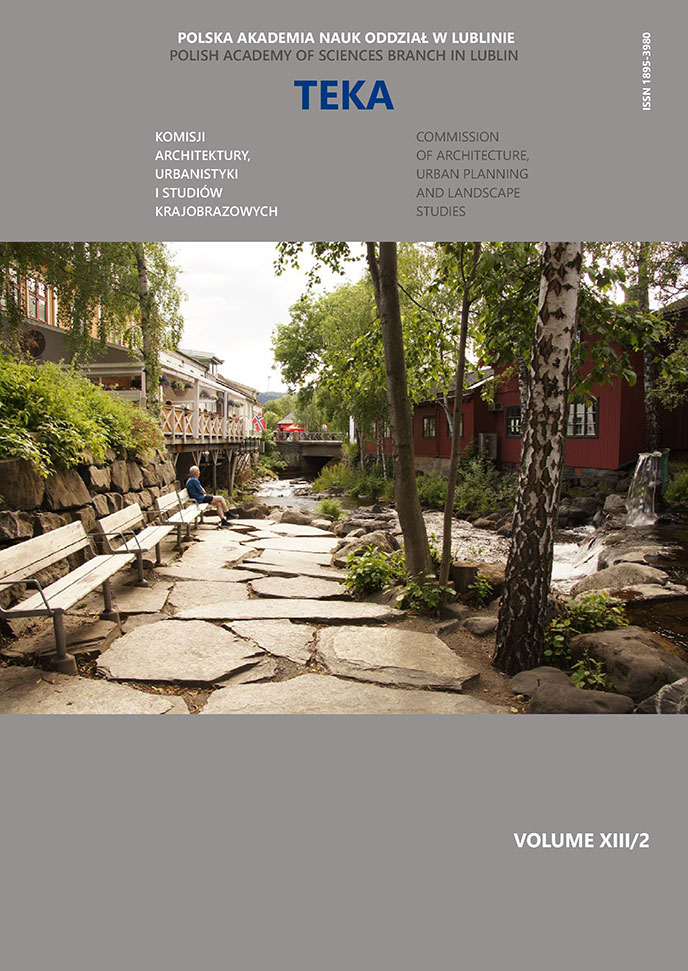Allison R.B., Wang X. 2015. Nondestructive teesting in the urban forest. [W:] Nondestructive evaluation of wood. (Red.) Ross R. J. General Technical Report FPL-GTR-238. Department of Agriculture, Forest Service, Forest Product Laboratory Madison, WI: U.S.: 77-86.
Brazee N. J., Marra R. E., Göcke L., Van Wassenaer P. 2011. Non-destructive assessment of internal decay in three hardwood species of northeastern North America using sonic and electrical impedance tomography. Forestry 84(1): 33-39.
DOI: https://doi.org/10.1093/forestry/cpq040
Chomicz E. 2007. Bezinwazyjne metody wykrywania defektów wewnątrz pni drzew stojących (Tomograf PiCUS® Sonic i PiCUS® Treetronic). Leśne Prace Badawcze 3: 117-121.
Chomicz E. 2010. Bezinwazyjne diagnozowanie kondycji drzew zabytkowych z zastosowaniem tomografów PiCUS®. Kurier Konserwatorski 8: 29-32.
Costello L.R., Quarles S.L. 1999. Detection of wood decay in blue gum and elm: an evaluation of the Resistograph® and the portable drill. J Arbor. 25: 311-318.
DOI: https://doi.org/10.48044/jauf.1999.041
Deflorio G., Fink S., Schwarze F. 2008. Detection of incipient decay in tree stems with sonic tomography after wounding and fungal inoculation. Wood Sci. Technol. 42: 117-132.
DOI: https://doi.org/10.1007/s00226-007-0159-0
Gilbert E.A., Smiley E.T. 2004. Picus Sonic Tomography for the quantification of decay in white oak (Quercus alba) and hickory (Carya spp.). Journal of Arboriculture 30(5): 277-281.
Göcke L., Rust S., Weihs U., Günther T., Rücker C. 2007. Combining sonic and electrical impedance tomography for the nondestructive testing of trees. Proceedings of the 15th International Symposium on Nondestructive Testing of Wood: September 10-12, Duluth, Minnesota, USA: 31-42.
Hayes E. 2001. Evaluating tree defects, 2nd ed. Safetrees, Rochester, MN. 34 pp.
Kazemi-Najafi S., Shalbafan A., Ebrahimi G. 2009. Internal decay assessment in standing beech trees using ultrasonic velocity measurement. Eur J Forest Res. 128: 345–350.
DOI: https://doi.org/10.1007/s10342-009-0269-3
Kuźniewski E. 1996. Ochrona przyrody na Śląsku Opolskim. Państwowy Instytut Naukowy, Instytut Śląski, Opole.
Luley C.L. 2005. Wood decay fungi common to living urban trees in the northeast and central United States. Urban Forestry LLC, Naples, NY. 61 pp.
Machanik A., Kurczewski R. 2014. Dziedzictwo przyrodnicze w rozwoju turystyki kulturowej na terenach wiejskich. Turystyka Kulturowa 7:34-48.
Majdecki L. 1980– 1986. Tabela wiekowa drzew. Rkps, Oddział Architektury Krajobrazu SGGW, Warszawa.
Matheny N.P., Clark J.R. 1994. Evaluation of hazard trees in urban areas, 2nd ed. International Society of Arboriculture, Savoy, IL: 85.
Mattheck C.G., Breloer H. 1994. The body language of trees: A Handbook of Failure Analysis. Her Majesty’s Stationery Office, London, UK: 240.
Nicolotti G., Socco L.V., Martinis R., Godio A. Sambuelli L. 2003. Application and comparison of three tomographic techniques for detection of decay in trees. Journal of Arboriculture 29: 66-77.
DOI: https://doi.org/10.48044/jauf.2003.009
Pacyniak C. 1988. Chrońmy drzewa pomniki - przyrody. Aura 10: 19-21.
PICUS Sonic Tomograph. Manual Program version Q72 http://www.sorbus-intl.co.uk/image/data/Picus/small_PiCUS_Q72_Manual_eng.pdf (dostęp 25.03.2016)
Pokorny J. 2003. Urban tree risks management: A community guide to program design and implementation. NA-TP-03-03. USDA Forest Service, Northeastern Area, State and Private Forestry, St. Paul, MN. 194 pp.
Przesmycka E. 2011. Alley as a determinant of the conservation status of the identity of the European cultural landscape on the example of south-eastern Poland. Architektura krajobrazu 1: 44-53
Pudelska K., Sosnowska M., Chyżewska R., Mirosław A., Rojek K. 2014. Commemorative trees as the evidence of the ancient city greenery of the Lublin’s Center [in.] Creative Urbanism Monograph, Lviv: 503-509.
Rabe C. Ferner D., Fink S., Schwarze F. W. M. R. 2004. Detection of decay in trees with stress waves and interpretation of acoustic tomograms. Arboric. J. 28: 3-19.
DOI: https://doi.org/10.1080/03071375.2004.9747399
Rejestr pomników przyrody w województwie lubelskim w 2014 r. http://bip.lublin.rdos.gov.pl/rejestr-form-ochrony-przyrody (dostęp 27.12.2014 r.)
Shigo A.L., Shortle W.C. 1985. Spruce budworms handbook: Shigometry - a reference guide. Agriculture Handbook No 646: U.S. Department of Agriculture, Forest Service, Cooperative State Research Service; 48pp.
Shortle W.C., Smith K.T. 1987. Electrical properties and rate of decay in spruce and fir Wood. Phytopathology 77(6): 811-814.
DOI: https://doi.org/10.1094/Phyto-77-811
Siewniak M. 1988. Ochrona drzew pomnikowych, Komunikaty Dendrologiczne 7: 3-15.
Siewniak M. 2010. Pielęgnowanie drzew – dzisiaj. Kurier Konserwatorski 8: 24-28.
Tattar T.A., Shigo A.L., Chase T. 1972. Relationship between the degree of resistance to a pulsed electric current and wood in progressive stages of discoloration and decay in living trees. Canadian Journal of Forest Research, 2(3): 236-243.
DOI: https://doi.org/10.1139/x72-039
Wang X., Allison R.B. 2008. Decay detection in red oak trees using a combination of visual inspection, acoustic testing, and resistance microdrilling. Arboriculture & Urban Forestry 34(1): 1–4.
DOI: https://doi.org/10.48044/jauf.2008.001
Wang X., Allison R.B. Wang L., Ross R.J. 2007. Acoustic tomography for decay detection in red oak trees. Research Paper FPL-RP-642. Madison WI:U.S. Department of Agriculture, Forest Service, Forest Products Laboratory: 1-7.
Wilcox W.W. (1988). Detection of early stages of wood decay with ultrasonic pulse velocity. For. Pro. J. 38: 5.
Współczynniki przyrostowe drzew. http://mdc.mo.gov/your-property/your-trees-and-woods/backyard-tree-care/how-old-tree (dostęp 27.02.2016 r.)


